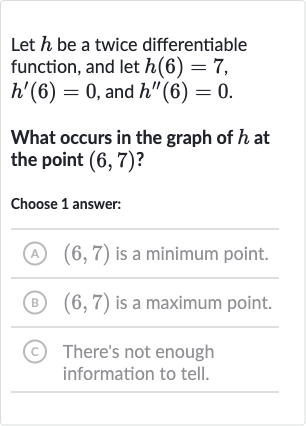Full solution
Q. Let be a twice differentiable function, and let , , and .What occurs in the graph of at the point ?Choose answer:(A) is a minimum point.(B) is a maximum point.(C) There's not enough information to tell.
- Analyze Given Information: To determine what occurs at the point on the graph of , we need to analyze the given information about the function and its derivatives at .Given: , , and .The value simply gives us the point on the graph, which is .The first derivative indicates that the slope of the tangent line to the graph of at is zero. This means that the graph has a horizontal tangent at this point, which could be a minimum, maximum, or a point of inflection.The second derivative provides information about the concavity of the graph at . Since the second derivative is zero, we cannot determine whether the graph is concave up or concave down at this point.
- Interpret First Derivative: To determine whether is a minimum or maximum point, or if there's not enough information, we would typically look at the sign of the second derivative. If h''(6) > 0, the graph would be concave up, and would be a minimum point. If h''(6) < 0, the graph would be concave down, and would be a maximum point.However, since , we cannot conclude whether the graph is concave up or down at that point. Therefore, we do not have enough information to determine if is a minimum or maximum point.

